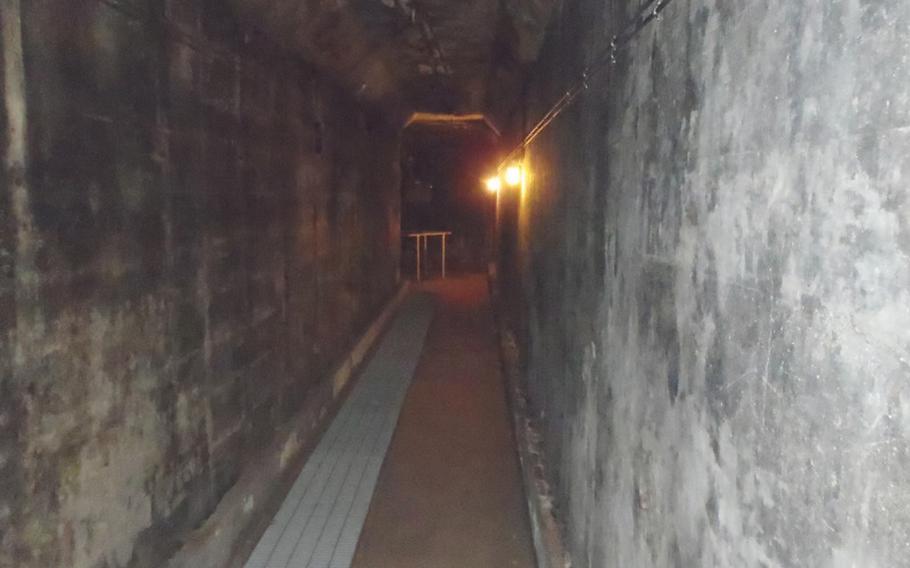
A burned-out corridor in the underground bunker complex that served as the air defense command center for most of southern Japan during World War II. Located near Sasebo Naval Base, the complex has been virtually left the same as it was after it was discovered and burned by American forces at the end of the war. The Japan Maritime Self-Defense Force operates a base on the ground above most of the site and sometimes gives tours of the complex. (Matthew M. Burke/Stars and Stripes)
On June 29, 1945, American fighters launched a raid on the Sasebo Naval District, an expansive base on the island of Kyushu in southern Japan. The Japanese defenders fired more than 600 artillery rounds from 13 air defense posts and 167 rounds from three heavy machine guns. They felled four American aircraft but were ultimately unable to stave off the attack.
The base suffered severe damage in the raid. However, a sprawling underground tunnel complex — the air defense command center for much of southern Japan — remained intact.
After the surrender of the Japanese a few months later, American GI boots touched Sasebo soil. They found the complex with its infrastructure and communications equipment protected by concrete walls several feet thick, steel blast doors, and underground tunnels that stretched across the city. They decided the only way to disarm the facility and render it ineffective was to watch it burn.
Today, thanks to time and a lack of human interference, the command center, blackened walls and all, is impeccably preserved, like the newly discovered tomb of a pharaoh in Egypt, an invaluable window into World War II and the Imperial Japanese war machine of the day.
Those seeking World War II historical sites in Japan need not look very far. History is everywhere, whether it be the kamikaze air bases in the south or the atomic bomb museum in Hiroshima. While the command center’s tunnels reportedly spider web below the city, its main rooms are located directly across the street from Sasebo Naval Base, home to ships from the U.S. Navy’s 7th Fleet, under a Japan Maritime Self-Defense Force base. In fact, one tunnel’s entrance is in view of the main gate to the U.S. base.
The tunnels reportedly connect to nearby Nimitz Park, which features sports fields shared by the American guests and Japanese civilians; some of the outlying American and Japanese military facilities; and possibly even the American Navy base itself. However, these deeper connecting tunnels that surely saw runners ferrying messages back and forth during the air raids are flooded and cannot be explored, JMSDF officials said.
During the war, the command center gave orders and managed the air defenses for Kyushu, mainland Japan’s southernmost island, and even extended to western Honshu, up to Hiroshima, and to western Shikoku, JMSDF officials said. As the American forces closed in toward the end of the war, it is likely the command center’s focus switched to offensive operations.
Vice Adm. Rokuzo Sugiyama was the center’s last commanding officer and he oversaw servicemembers, officers, a commissioner, the chief of staff, and female workers, JMSDF officials said. The air defense center boasted a revolutionary air conditioning system that pumped cool air to every room in the complex. Covered in rust, it can still be seen today.
The main room had a huge map to manage air defenses, according to JMSDF officials, and was the command hub. In an adjoining room, there were phone lines connecting the command center with air bases in Omura, Sasebo, Kanoya, Hakata and Kagoshima so that orders could be exchanged and information relayed.
Now, the eerie, burned-out complex must be navigated using flashlights. The concrete floor is crumbling in some spots, and tiles are loose.
Debris decorates the complex. Mostly illegible writing in English and Japanese is scrawled onto the walls.
The drainage system is still there. The bathrooms are partially caved in, but guests can see the open stalls and toilets and the sign overhead designating the one with privacy for officers. In the corner, unmoved since shortly after World War II, is the sign left by the American occupying forces designating the newly burned facility off limits. It is covered in more than 50 years of dust.
In the middle of one of the corridors is a small, stairway winding down even deeper into the abyss. This narrow stairwell is tricky to navigate, but the room at the bottom opens up to a large stairwell that descends even further underground. This allegedly connects with facilities all over the city.
However, that is where my tour ends.
A flashlight can penetrate the water, which has risen almost to the top of the stairwell, for about 10 feet, but after that, nothing but blackness.
The Japanese have set up a few portable lights in the command center in case they have to enter. Several spools of barbed wire and supplies are stored, but other than that, it remains locked, officials said.
It’s not open to the public, but JMSDF occasionally escorts visitors on request.
What will become of the facility? Will the JMSDF offer tours en masse someday? Will it become a museum? Will it be filled in?
“What does the JMSDF plan to do with it?” I asked the JMSDF officer who served as my guide through my translator. He paused, and said one word.
I didn’t even need to ask for a translation.
“Nothing,” he said.
And that is exactly what is so beautiful about the complex.
Stars and Stripes’ Elena Sugiyama contributed to this report.